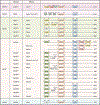The NLR family of innate immune and cell death sensors
- PMID: 38599165
- PMCID: PMC11112261
- DOI: 10.1016/j.immuni.2024.03.012
The NLR family of innate immune and cell death sensors
Abstract
Nucleotide-binding oligomerization domain (NOD)-like receptors, also known as nucleotide-binding leucine-rich repeat receptors (NLRs), are a family of cytosolic pattern recognition receptors that detect a wide variety of pathogenic and sterile triggers. Activation of specific NLRs initiates pro- or anti-inflammatory signaling cascades and the formation of inflammasomes-multi-protein complexes that induce caspase-1 activation to drive inflammatory cytokine maturation and lytic cell death, pyroptosis. Certain NLRs and inflammasomes act as integral components of larger cell death complexes-PANoptosomes-driving another form of lytic cell death, PANoptosis. Here, we review the current understanding of the evolution, structure, and function of NLRs in health and disease. We discuss the concept of NLR networks and their roles in driving cell death and immunity. An improved mechanistic understanding of NLRs may provide therapeutic strategies applicable across infectious and inflammatory diseases and in cancer.
Keywords: DAMP; IL-18; IL-1β; NF-κB; NLR; NLR network; PAMP; PANoptosis; PANoptosome; RIPK; apoptosis; caspase-1; gasdermin; inflammasome; inflammatory cell death; innate immune cell death; interferon; necroptosis; pattern recognition receptor; pyroptosis.
Copyright © 2024 The Author(s). Published by Elsevier Inc. All rights reserved.
Conflict of interest statement
Declaration of interests T.-D.K. is a member of the Immunity advisory board.
Figures



References
-
- Janeway CA Jr. (2013). Pillars article: approaching the asymptote? Evolution and revolution in immunology. Cold Spring Harb Symp Quant Biol 1989. 54: 1–13. J Immunol 191, 4475–4487. - PubMed
Publication types
MeSH terms
Substances
Grants and funding
LinkOut - more resources
Full Text Sources

